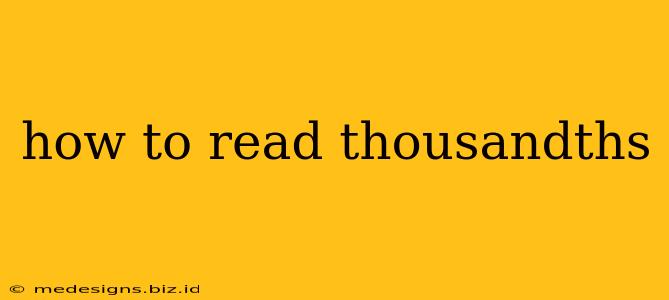Understanding thousandths can seem daunting at first, but with a little practice, it becomes straightforward. This guide breaks down how to read and understand this fractional unit, covering various representations and real-world applications.
Understanding Thousandths
A thousandth represents one part out of one thousand equal parts of a whole. It's a fraction with a denominator of 1000, and it can be written in several ways:
- Fraction: 1/1000
- Decimal: 0.001
- Percentage: 0.1%
Think of it like slicing a cake into 1000 equal pieces. One of those slices represents one thousandth of the whole cake.
Reading Thousandths in Decimal Form
Decimal representation is the most common way to encounter thousandths. The key is understanding the place value system:
- Ones: The digit to the left of the decimal point represents the whole number.
- Tenths: The first digit to the right of the decimal point represents tenths (1/10).
- Hundredths: The second digit represents hundredths (1/100).
- Thousandths: The third digit represents thousandths (1/1000).
Example:
Let's take the decimal 0.275.
- 0: Represents the whole number (zero in this case).
- 2: Represents 2 tenths (2/10 or 0.2).
- 7: Represents 7 hundredths (7/100 or 0.07).
- 5: Represents 5 thousandths (5/1000 or 0.005).
Therefore, 0.275 is read as "two hundred seventy-five thousandths."
Real-World Applications of Thousandths
Thousandths appear in various aspects of daily life and professional fields, including:
- Precision Measurement: Engineering, manufacturing, and scientific fields often require measurements accurate to the thousandth of an inch or millimeter.
- Finance: Interest rates, stock prices, and currency exchange rates can be expressed with precision to thousandths.
- Statistics: Data analysis frequently involves values expressed to the thousandth to represent precise proportions or probabilities.
- Science: Scientific measurements, particularly in fields like chemistry and physics, often involve values to the thousandth.
Practicing Reading Thousandths
The best way to master reading thousandths is through practice. Try converting fractions to decimals and vice versa. Here are some examples to try:
- Convert 3/1000 to a decimal. (Answer: 0.003)
- Convert 0.048 to a fraction. (Answer: 48/1000, which simplifies to 6/125)
- Read the decimal 0.129 aloud. (Answer: One hundred twenty-nine thousandths)
Conclusion
Understanding thousandths is a fundamental skill with broad applications. By understanding the place value system and practicing conversion, you can confidently read, write, and use thousandths in various contexts. Remember to break down the decimal into its component parts (tenths, hundredths, and thousandths) to ensure accurate reading and comprehension.
